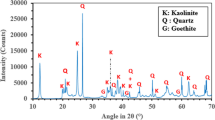Abstract
Adobe is an extremely simple form of earth construction and with this technique the shrinkage associated with the construction of large structures is avoided. In Portugal, earthen materials have been used in load-bearing walls in the form of adobe or rammed earth for the construction of buildings especially in the southern and central coast. Most conventional consolidation treatments used in the past have not succeeded in providing a long-term solution because they did not tackle the main cause of degradation, the expansion and contraction of constituent clay minerals in response to humidity changes. Clay swelling could be reduced significantly by transforming clay minerals into non-expandable binding materials with cementing capacity using alkaline activation. in this study it was being developed adobes with water, and alkaline activated with NaOH and KOH. The obtained results allowed to conclude that the adobes with NaOH and KOH have an increase of its properties.
You have full access to this open access chapter, Download conference paper PDF
Similar content being viewed by others
Keywords
1 Introduction
The use of adobe construction in the Aveiro district reflected the properties of the existing raw materials available to be applied, namely sand, clay sediments and soils and lime (Silveira et al. 2012), and there is an evident heterogeneity of the adobes linked to the geographic distribution of the available resources. In Aveiro there was a semi-industrial production of adobe, some small companies employing ‘adobeiros’, for the manufacture of blocks of adobe, along with a domestic self-production (Costa et al. 2016). Most conventional consolidation treatments used in the past have not succeeded in providing a long-term solution because they did not tackle the main cause of degradation, the expansion and contraction of constituent clay minerals in response to humidity changes. Clay swelling could be reduced significantly by transforming clay minerals into non-expandable binding materials with cementing capacity using alkaline activation.
2 Methods and Approaches
The chemical composition of diatomite samples was assessed by X-ray fluorescence (XRF), qualitative mineralogical analyses were carried out by X- ray diffraction (XRD). Compressive strength tests use a universal mechanical compression testing machine (Shimadzu Autograph AG 25 TA).
3 Results and Conclusions
Mineralogically, samples are composed by quartz, feldspars and phyllosilicates, however, there is an evidence of the presence of amorphous alumino-silicate phases. Samples with higher mechanical strength are associated with higher specific surface areas, namely, those with NaOH. The alkaline activation promotes the increase of mechanical resistance. With the exception of one sample, all the samples present promising mechanical resistances for their application in rehabilitation works on adobe buildings, since these do not require high resistance, even for the sake of compatibility.
References
Costa CS, Rocha F, Velosa AL (2016) Sustainability in earthen heritage conservation. Sustainable use of traditional geomaterials in construction practice. Geol Soc London, Spec Publ 416. http://doi.org/10.1144/SP416.22
Silveira D, Varum H, Costa A, Martins T, Pereira H, Almeida J (2012) Mechanical properties of adobe bricks in ancient constructions. Constr Build Mater 28:36–44
Author information
Authors and Affiliations
Corresponding author
Editor information
Editors and Affiliations
Rights and permissions
Open Access This chapter is licensed under the terms of the Creative Commons Attribution 4.0 International License (http://creativecommons.org/licenses/by/4.0/), which permits use, sharing, adaptation, distribution and reproduction in any medium or format, as long as you give appropriate credit to the original author(s) and the source, provide a link to the Creative Commons license and indicate if changes were made.
The images or other third party material in this chapter are included in the chapter's Creative Commons license, unless indicated otherwise in a credit line to the material. If material is not included in the chapter's Creative Commons license and your intended use is not permitted by statutory regulation or exceeds the permitted use, you will need to obtain permission directly from the copyright holder.
Copyright information
© 2019 The Author(s)
About this paper
Cite this paper
Costa, C. et al. (2019). Alkaline Activation of Rammed Earth Material – “New Generation of Adobes”. In: Glagolev, S. (eds) 14th International Congress for Applied Mineralogy (ICAM2019). ICAM 2019. Springer Proceedings in Earth and Environmental Sciences. Springer, Cham. https://doi.org/10.1007/978-3-030-22974-0_75
Download citation
DOI: https://doi.org/10.1007/978-3-030-22974-0_75
Published:
Publisher Name: Springer, Cham
Print ISBN: 978-3-030-22973-3
Online ISBN: 978-3-030-22974-0
eBook Packages: Earth and Environmental ScienceEarth and Environmental Science (R0)




